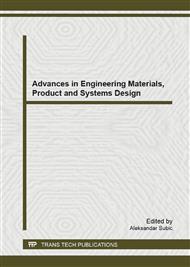[1]
S. Kuzmanović, M. Vereš, M. Rackov, Product Design as the Key Factor for Development in Mechanical Engineering, Proceedings of International Conference Mechanical Engineering in XXI Century, Niš, 25-26 November 2010, ISBN 978-86-6055-008-0, 113-116.
Google Scholar
[2]
R. Kasuba, Dynamic Loads in Normal and High Contact Ratio Spur Gearing, International Symposium on Gearing and Power Transmissions, Tokyo (1981) 49-55.
Google Scholar
[3]
T. Sato, K. Umezawa, J. Ishikawa, Effect of Contact Ratio and Profile Correction of Spur Gears on the Rotational Vibrations, Bulletin of the JSME. 26 (221) (1983) 2010-(2016).
DOI: 10.1299/jsme1958.26.2010
Google Scholar
[4]
A. Kahraman, G.W. Blankenship, Effect of Involute Contact Ratio on Spur Gear Dynamics, ASME Journal of Mechanical Design. 121 (1999) 112-118.
DOI: 10.1115/1.2829411
Google Scholar
[5]
M. Vereš, S. Kuzmanović, M. Rackov, Experimental Research of HCR Gearing From Pitting Damage Point of View, Proceedings of 7th International Symposium about Mechanical and Industrial Engineering, KOD 2012, ISBN 978-86-7892-399-9, 317-320.
DOI: 10.2478/stu-2014-0010
Google Scholar
[6]
J. Medzihradský, Experimental and Theoretical Studies of HCR Gearing: Optimization and Resistance to Pitting Damage, Thesis, Slovak University of Technology in Bratislava, Faculty of Engineering, Bratislava, October 2009 (In Slovak).
DOI: 10.24916/iansa.2013.2.4
Google Scholar
[7]
Bonfiglioli Riduttori S. p.A. (Eds. ), Gear Motor Handbook, Springer-Verlag, Berlin, (1995).
Google Scholar
[8]
A.R. Hassan, Contact Stress Analysis of Spur Gear Teeth Pair, World Academy of Science, Engineering and Technology. 58 (2009).
Google Scholar
[9]
S. Kuzmanović, Universal Gear Reducers with Cylindrical Gears, University of Novi Sad, Faculty of Technical Sciences, Novi Sad, p.231 (in Serbian), (2009).
DOI: 10.24867/grid-2020-p68
Google Scholar
[10]
M. Vereš, M. Bošanský, M. Rackov, Theoretical and Experimental Research of the HCR Gear's Contact Strength, Machine Design. ISSN 1821-1259, 3(2) (2011) 105-108.
Google Scholar
[11]
M. Rameshkumar, P. Sivakumar, S. Sundaresh, K. Gopinath, Load Sharing Analysis of High-Contact-Ratio Spur Gears in Military Tracked Vehicle Applications, Geartechnology. July (2010).
Google Scholar
[12]
E. Podzharov, A. Mozuras, J.A. Alvarez Sanchez, Design of High Contact Ratio Spur Gears to Reduce Static and Dynamic Transmission Error, Ingeneria Mecanica. 1 (2003) 85-90.
Google Scholar
[13]
S. Kuzmanović, Machine Elements, University in Novi Sad, Faculty of Technical Sciences, Novi Sad (2010).
DOI: 10.24867/grid-2020-p68
Google Scholar
[14]
M. Veres, B. Harman, S. Kuzmanović, M. Rackov, Determination of the Correct Mating Cylindrical Teeth Flanks Profiles When The Path of Contact is Given, Scientific Proceedings, Faculty of Mechanical Engineering, STU in Bratislava, ISBN 978-80-227-3326-7, (2009).
Google Scholar
[15]
J. Kennedy, R.C. Eberhart, Particle Swarm Optimization, Proceedings of IEEE International Conference on Neural Networks, Perth, Australia (1995) 1942-(1948).
Google Scholar
[16]
A. Ratnaweera, K.H. Saman, H.C. Watson, Self-Organizing Hierarchical Particle Swarm Optimizer With Time-Varying Acceleration Coefficients, IEEE Transactions on Evolutionary Computation. 8(3) (2004) 240-255.
DOI: 10.1109/tevc.2004.826071
Google Scholar
[17]
J. C Schutte, A.A. Groenwold, A Study of Global Optimization Using Particle Swarms, Journal of Global Optimization. 31 (2005) 93-108.
DOI: 10.1007/s10898-003-6454-x
Google Scholar
[18]
Y. Shi, R.C. Eberhart, Empirical study of particle swarm optimization, Proceedings of IEEE International Congress on Evolutionary Computation. 3 (1999) 101-106.
Google Scholar
[19]
M.R. Rapaić, Ž. Kanović, Time-varying PSO - convergence analysis, convergence related parameterization and new parameter adjustment schemes, Information Processing Letters. 109 (2009) 548-552.
DOI: 10.1016/j.ipl.2009.01.021
Google Scholar
[20]
Ž. Kanović, M.R. Rapaić, Z.D. Jeličić, Generalized Particle Swarm Optimization Algorithm - Theoretical and Empirical Analysis with Application in Fault Detection, Applied Mathematics and Computation. 217 (2011) 10175-10186.
DOI: 10.1016/j.amc.2011.05.013
Google Scholar
[21]
K.J. Ǻström, B. Wittenmark, Computer-Controlled Systems - Theory and Design, 3rd ed., Prentice Hall (1997).
Google Scholar


